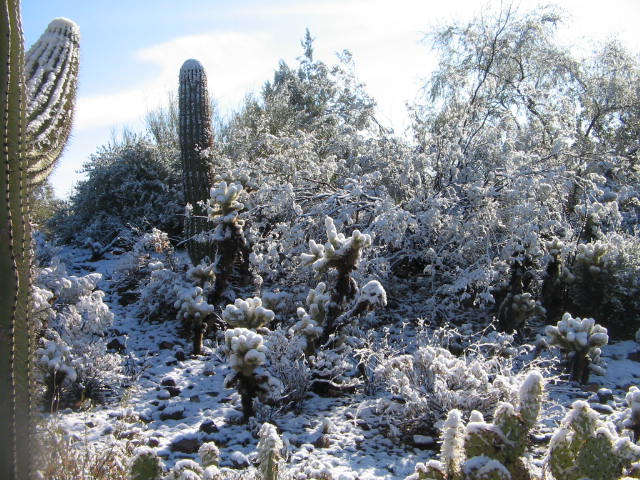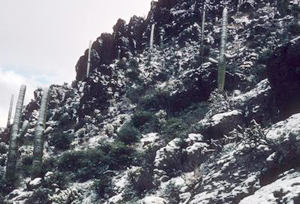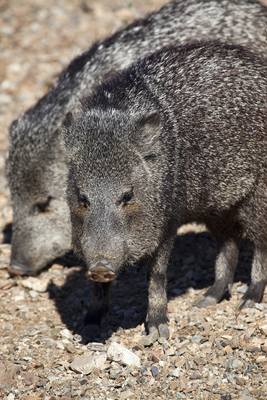
The Coati (co-AH-tee) is a relative of the raccoon with a long nose, masked face, and a striped tail. Coatis are curious and energetic, just like kids!
Coati Club News, January 2016
Winter Wonderland
When we think of deserts, what usually comes to mind? Dry landscapes with searing heat. Here in the Sonoran Desert, it is hot and dry throughout much of the year, but right now that’s a distant memory. At night or the early morning, you need a warm jacket, gloves and a winter hat to keep warm.

Snow at the Desert Museum
© 2007 ASDM
Winter here comes in December and January, and sometimes stretches into early February. Days can be sunny and mild but nights can be downright freezing, especially after a storm moves through. We get about half our yearly rainfall in winter. Storms are gentler than the summer monsoon downpours. Winter storms sometimes bring snow. Rain puddles freeze in the chill of night. You have to be a hardy plant or animal to be able to survive the extreme heat of the summer and the cold of winter. How do our year-round residents do it?
Plants

Snow in Gates Pass
© 1985 ASDM
Cold is more of a threat to desert plants that heat, especially for plants that store water. Freezing temperatures damage plant tissues (try the “Ice Experiment” below to see why.) Many young and old saguaros, for example, die because of deep freezes. Young saguaros need the protection of a nurse plant, whose branches work like a blanket to block frosty air, as well as a series of mild winters to help get their best start. Old plants that outgrow their nurse trees are larger and take longer to freeze. But frost damage can kill enough of the plant that it weakens and dies.
With freezing temperatures, some plants like mesquite, palo verde, and sycamore trees drop their leaves. But fueled by winter rains, other plants like brittlebush, ocotillo, and creosote sprout new leaves. Spring-blooming wildflower seedlings stay tiny until spring’s warmer temperatures trigger them to grow quickly and flower.
Animals

Javelina, Pecari tajacu
© 2010 Rhonda Spencer
If you were a creature adapted to the heat, would you want to come out in the cold? Not unless you had on a warm coat! That’s true for many desert animals, as well. Birds have downy feathers to keep them warm. Mammals grow thicker coats in winter. Some, like javelina and deer, and their predators like mountain lions, become more active in the daytime because it is warmer. And burrowing animals like packrats and kangaroo rats use their underground nests for protection from winter’s chill.
Warm coats don’t help if you can’t make your own heat. For animals whose body temperatures change with environmental temperatures, wintertime is too cold to be active. Reptiles like tortoises hibernate in their burrows from October to April. Lizards and snakes retreat to underground dens, but snakes will bask in the sun on a warm day even in winter. Toads and frogs bury themselves deep in the mud and wait for the summer rainy season before they emerge again. Arthropods like tarantulas, scorpions, and insects hide in their burrows or under rocks until it warms up.
But they don’t have to wait long. By late February, spring arrives in the desert, and in wet years, March and April bring dazzling wildflowers and lots of animal babies. So enjoy our little bit of winter wonder while it lasts!
Ice Experiment
What happens to water in temperatures below freezing?
It turns to ice. But does frozen water - ice - take up more space than liquid water? Test it.
- Carefully fill a one-cup measuring cup with ½ cup of water.
- Put the cup in the freezer and pull it out after a few hours when the water freezes.
Is the frozen water line at the same level as the liquid? You should see that it expanded. This is why freezing temperatures are hard on water-storing desert plants. Their cells burst when the water inside turns to ice.

